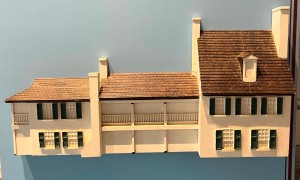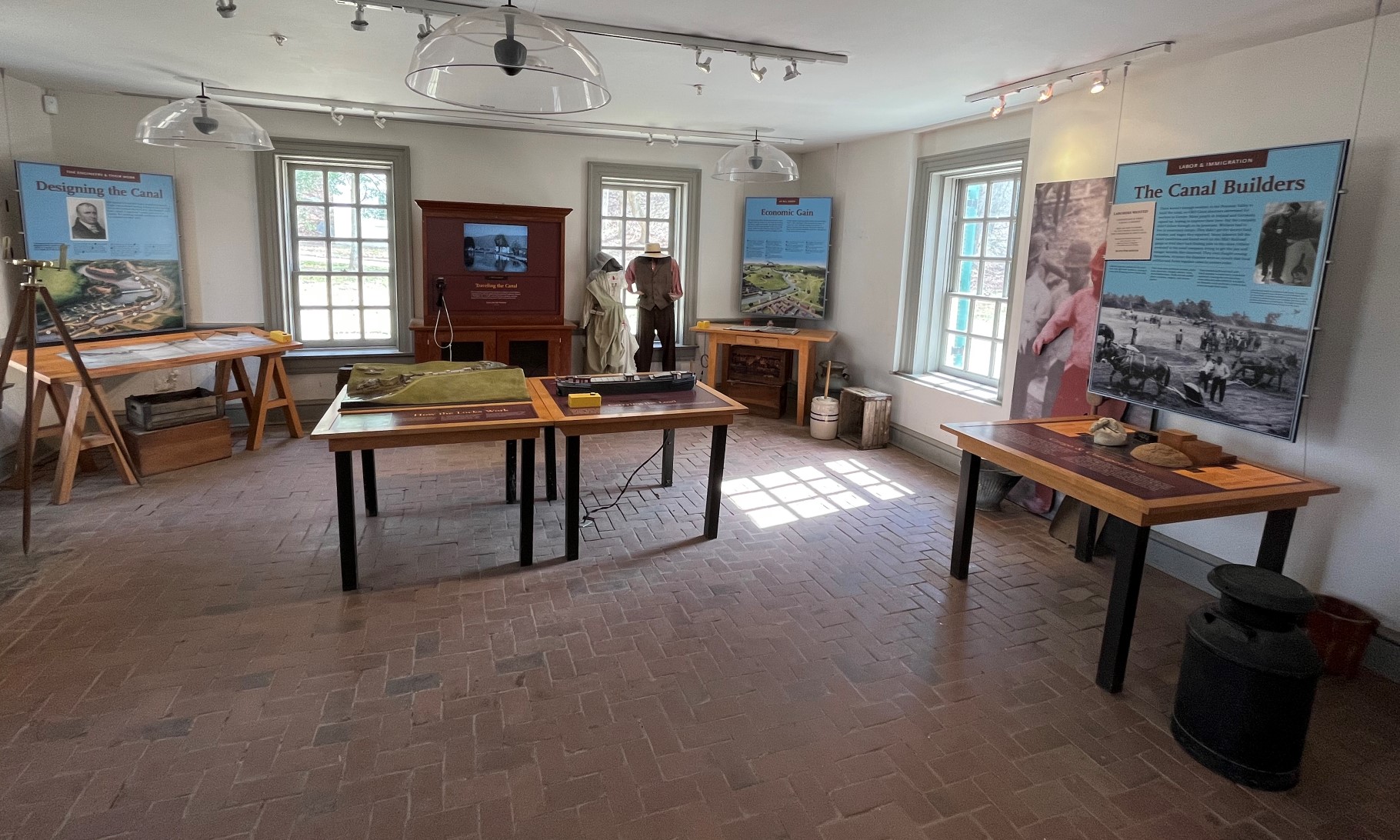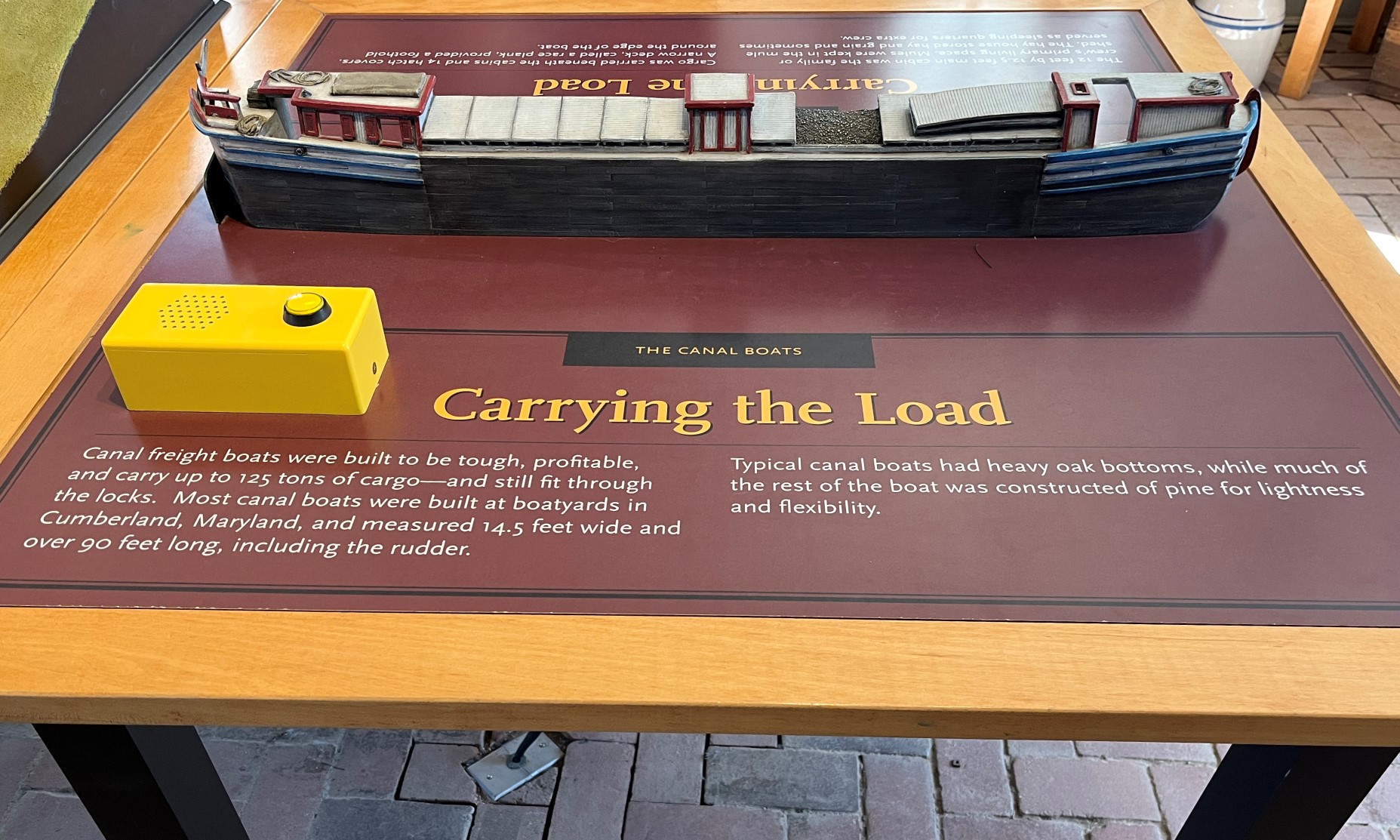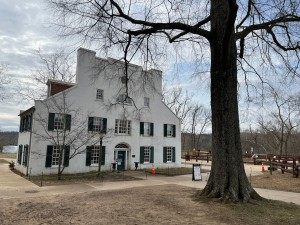Many who enter this building dearly wish it was still a tavern. They’ve hiked the notorious “A” section of the nearby Billy Goat Trail or biked the entire C&O Canal towpath from Cumberland, Maryland, 170 miles away. A few hardy souls have walked from Cumberland, carrying a heavy backpack and camping at the primitive sites spaced about every five miles or so along the canal.
They arrive here tired and sweaty, and I wish I could pour them an ale or tingle their tongues with a glass of soda if they prefer. But alas, I cannot even offer them a bottle of water or a place to dump their trash. The C&O Canal National Historical Park is a “carry-it-in / carry-it-out” park. I can only offer a plastic trash bag. Sorry.
But most who come through the door are here just for a walk on the towpath or up the short boardwalk trail to the overlook to see the Great Falls of the Potomac River. They’ve stepped into the tavern to pick up a park or trail map, explore the exhibits, or check out what’s inside this odd-looking historic building.
Welcome to Great Falls Tavern.
A Little History
The building now generally referred to as Great Falls Tavern actually comprises three separate but attached structures. Shortly after ground was broken for the C&O Canal in 1828, a lockhouse for the yet-to-be built lock was constructed here. The lockkeeper soon convinced the canal company to add a tavern to offer food, drink, and lodging, as Great Falls was already a popular local attraction.
In 1830–31, a three-story tavern was added onto the north end of the lockhouse. It had a barroom and ballroom on the main floor, individual and dormitory rooms on the second floor, and a “honeymoon suite” on the third floor. Also, the roof was raised on the original lockhouse and a smaller two-story addition built onto its south end, for use by the lockkeeper and his family. The tavern was named Crommelin House, in honor of Dutch investors in the canal.
The tavern underwent many changes in use over the years. In 1849, as the canal was nearing completion, the canal company decided to forbid the sale of alcohol on its property and closed the tavern operation. For years, the main floor was leased as a grocery store, while the upstairs served as a hotel. When the hotel and grocery businesses closed in the early 1900s, the former tavern was leased to a private club.
After a devastating flood finally ended canal operations in 1924, the building reverted to a tavern again for a while. Then the Park Service leased it as a refreshment stand and boat concession. Demolition was considered after a structural fire damaged the building in 1948, but fortunately the tavern was restored for use as a museum instead. Now part of the C&O Canal National Historical Park, it houses a visitor center on the ground floor and offices and other rooms for park staff upstairs.

The building’s odd structural amalgamation makes getting around interesting. To go from one room to another on the ground level, you have to go outside, as none of the three sections of the building connect to one another by doors. To go upstairs, you have to use an external stairway. The three sections of the building don’t directly connect on the second floor either. You have to use the outdoor landing to go from room to room. I don’t even know how to reach the third floor of the tavern, the former “honeymoon suite.” Climb a ladder? Rappel up a wall to a window? Who knows what’s up there now.
Open the Door and Come on In
A necessary clarification: Great Falls Tavern is the visitor center for this section of the C&O Canal National Historical Park in Maryland. Great Falls Park, also a national park site, is right across the river in Virginia and has its own visitor center (currently being renovated). So when you talk about going to Great Falls, you have to clarify which side of the river you mean.
Anyhow, step inside. You’ll find yourself in a large room that certainly looks historic, with its brick floor, plaster walls, and twin fireplaces. In the center is the information desk, with its racks of brochures and a helpful park service volunteer standing by to assist you. The rest of the space contains various exhibits and objects. You’re pretty much free to put your hands on any of them, even the musical instruments an interpretive ranger recently put out. So strum away.

You can read about the history of the canal and how it was designed and built, examine models of a lock and a canal boat, enjoy touchable and even sniffable items, and watch the silent 12-minute video “Down the Old Potomac,” produced by Thomas Edison’s company in 1917, showing a trip down the canal by boat.
Unfortunately, what you won’t see are shelves and racks of anything for sale—guidebooks, calendars, postcards, tee-shirts, park passports, and so on—that you’d expect to find here. The retail operation, run by the park’s cooperating association, Eastern National, closed along with the visitor center during the covid pandemic. It hasn’t yet returned. [Update: It has reopened!]



Step outside through the back doors and you’ll find another room in the central part of the building, the oldest section that used to be the lockhouse. Now it contains hands-on activities for kids that continually change. A third room on the ground level, which has a video presentation on the park, is currently closed. [Update: It has reopened!]
Working Here as a Volunteer
The tavern is open from 9:00 a.m. to 4:00 p.m. Wednesday to Sunday. It is usually staffed by one or more volunteers or by a park ranger if a volunteer isn’t available. The day is divided into two shifts: 9:00 to 12:30 and 12:30 to 4:00. Since February 2023, I’ve been working the Wednesday afternoon shift.
Wednesdays are far less busy in the park than weekends and holidays, so the visitor-greeting business in the tavern can get a little slow. (I always bring something to read for when I’m hanging around in there alone.) But there’s usually an intermittent trickle of people and an occasional surge. Recently, a large elementary school group flooded the place for what seemed like half an hour. I could barely hear myself think. Silence and solitude were a relief after that.



I worked as a visitor center volunteer for several years at the Smithsonian’s National Museum of Natural History. There I was usually busier and had many more visitor contacts on a given day. But my interactions with visitors at the tavern, while fewer in number, are generally much more interesting and gratifying. While many people come in just to pick up a map or browse the exhibits and prefer to be left alone, many others ask interesting questions or chat with me about the park, their memories of it, or their appreciation for it.
If I don’t know the answer to a visitor question or I’m a little unsure about it, I make a point to find out later. This broadens my knowledge of the park and makes me better able to answer the same question again, as it will surely come up. One day I was asked twice about Supreme Court justice William O. Douglas and his role in getting the park established. I went home and reread the passages about him in my guidebooks.
“I Have a Question”
What people most often ask about:
- Why is there no water in the canal? There’s a major canal maintenance project going on involving dredging a section of the canal bed and clearing debris and obstacles from it in several other areas. The canal had to be drained for this purpose.
- Will you ever have mule-pulled canal boat rides again? Yes, once the maintenance project is done and the canal can be rewatered. The boat is ready, and you may see rangers taking the mules for a walk on the towpath.
- Do you sell national parks passes here? They are sold at the entrance station—when it is staffed. Often on weekdays it is not because of lack of personnel. You can also buy them at Great Falls Park in Virginia.
- If there’s no one at the entrance station, do I have to pay park admission? You can drive (or bike or walk) right in without paying (the gate will go up). You can pay online; there’s a QR code posted in the tavern that you can scan to reach the website. But it’s on the honor system, so it’s up to you. Every paid admission helps the park.
- Do you have date stamps for Park Passport books? Yes, we have several: for the park, the Billy Goat Trail, and several of the lockhouses you can stay in via the C&O Canal Trust’s Canal Quarters program.
- Do you have any Junior Ranger activity booklets? Yes, they are quite popular, and we hand out Junior Ranger badges when your child completes the activities. One of our park rangers performed a Junior Ranger swearing-in ceremony for the entire school group that overran the visitor center that one day.
Other interesting questions:
- Were slaves used to build the canal? No. Immigrant laborers from Europe, mainly from Ireland and Germany, made up most of the workforce. Several people have asked about this.
- Was George Washington involved in building the canal? No, but he founded a company in 1784 to build a series of shorter canals to skirt several unnavigable stretches of the Potomac. In Great Falls Park in Virginia, you can see the remains of one of those early canals built to bypass Great Falls.
- How does water get into the canal? Via dams and inlet locks that divert water into the canal from the Potomac. The inlet lock at Violettes Lock (Mile 22) waters the canal from there to Great Falls (Mile 14) and on down to Lock 5 (Mile 5). The inlet lock at Lock 5 waters the canal the rest of the way to Georgetown.
- Where can I park to get to Little Falls? Yes, there is a “Little Falls” downriver from Great Falls. I had to consult Google Maps to find it. It’s just upriver from Chain Bridge (I think you can see it from there). You can park in several places nearby within walking distance, but it doesn’t appear to be easily accessible. One of these days, I’ll go out and see if I can find a trail to it from the towpath. Incidentally, this was among the stretches of river bypassed by one of those 18th-century canals.
- Are there bears in the park? Not that I know of, at least in the Great Falls area. But bears have been spotted on rare occasions in local suburban neighborhoods even closer to Washington.
- What about poisonous snakes? Yes, copperheads, which can sometimes be seen on the towpath. There are many other common nonpoisonous snakes too.
- Does the tavern ever get flooded? On rare occasions when the river level is extraordinarily high, floodwaters can reach the tavern. In that event, park rangers stack sandbags around the building. I have videos clips on my cellphone of two major floods in 2018 that I took from both sides of the river. I’ve shown them to especially interested visitors.

Come Visit!
One of these days, I’ll write a post comparing the parks on both sides of the river at Great Falls, as they offer different but complementary experiences. But this is it for now. As I mentioned, I volunteer at the tavern every Wednesday afternoon unless I’m traveling. Stop by and say hello!
David Romanowski, 2023



Pingback: Great Falls: Maryland and Virginia | Bike Walk Drive